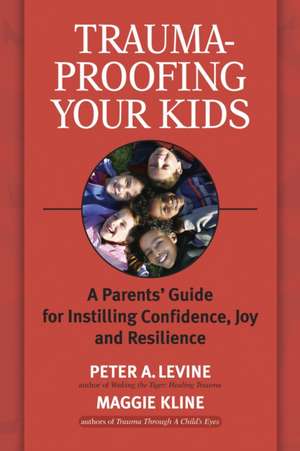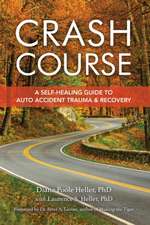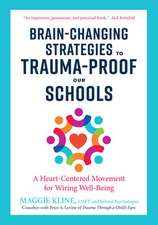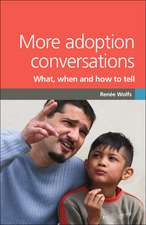Trauma-Proofing Your Kids: A Parents' Guide for Instilling Confidence, Joy and Resilience
Autor Peter A. PH.D. Levine, Maggie Klineen Limba Engleză Paperback – 29 feb 2008
In addition to arming parents with priceless protective strategies, best-selling authors Dr. Peter A. Levine and Maggie Kline offer an antidote to trauma and a recipe for creating resilient kids no matter what misfortune has besieged them. Trauma-Proofing Your Kids is a treasure trove of simple-to-follow “stress-busting,” boundary-setting, sensory/motor-awareness activities that counteract trauma’s effect on a child’s body, mind and spirit. Including a chapter on how to navigate the inevitable difficulties that arise during the various ages and stages of development, this ground-breaking book simplifies an often mystifying and complex subject, empowering parents to raise truly confident and joyful kids despite stressful and turbulent times.
Preț: 91.11 lei
Preț vechi: 108.27 lei
-16% Nou
Puncte Express: 137
Preț estimativ în valută:
17.44€ • 18.93$ • 14.65£
17.44€ • 18.93$ • 14.65£
Carte disponibilă
Livrare economică 02-09 aprilie
Livrare express 18-22 martie pentru 43.59 lei
Preluare comenzi: 021 569.72.76
Specificații
ISBN-13: 9781556436994
ISBN-10: 1556436998
Pagini: 235
Ilustrații: COLOR ILLUS.
Dimensiuni: 152 x 229 x 18 mm
Greutate: 0.4 kg
Ediția:1
Editura: NORTH ATLANTIC BOOKS
ISBN-10: 1556436998
Pagini: 235
Ilustrații: COLOR ILLUS.
Dimensiuni: 152 x 229 x 18 mm
Greutate: 0.4 kg
Ediția:1
Editura: NORTH ATLANTIC BOOKS
Notă biografică
Peter A. Levine, PhD, is the developer of “Somatic Experiencing” and founder of the Foundation for Human Enrichment. A NASA consultant, he lives in Encinitas, CA. Maggie Kline, MFT, has more than 30 years of experience as a teacher, family and child therapist, school psychologist, and parent. She lives in Long Beach, CA.
Extras
The bad news is that trauma is a fact of life. The good news is that so is resilience. Simply stated, resilience is the capacity we all possess to rebound from stress and feelings of fear, helplessness and overwhelm. The analogy sometimes given for resilience is that of a metal spring, such as a “Slinky.” If you pull it apart, the coil naturally rebounds to its original size and shape. Of course, if you stretch this spring too many times (or exert too much force), it will eventually lose its elasticity.
People (especially young people), however, need not lose their resilience through wear and tear. On the contrary, we have the capacity to actually build and increase our resilience as we encounter the stresses and strains of life. Resilient children tend to be courageous. This doesn’t mean that they are attracted to dangerous situations, but rather that they are open and curious as they explore their world with gusto and exuberance. And, in their explorations, they inevitably have their share of rumbles and tumbles, collisions and conflicts.
When resilient kids meet these forces of nature, they are open rather than shut down. Openness, indeed, is the characteristic that most typifies resilient kids. They are open to other children and enjoy sharing with them. At the same time, they are able to set boundaries of their own personal space and their possessions. They are in touch with their feelings, expressing and communicating them in age-appropriate ways. And, most of all, when bad things happen, they have a wondrous capacity (when supported) to breeze through them. They are the happy, lively children we wish we were. Their biggest challenges occur from events that could be potentially traumatic. Let’s delve into what types of life’s circumstances might cause such overwhelming reactions in our kids.
Trauma can result from events that are clearly extraordinary such as violence and molestation, but it can also result from everyday “ordinary” events. In fact, common occurrences such as accidents, falls, medical procedures and divorce can cause children to withdraw, lose confidence, or develop anxiety and phobias. Traumatized children may also display behavioral problems including aggression, hyperactivity and, as they grow older, addictions of various sorts. The good news is that with the guidance of attuned parents and other caregivers who are willing to learn the necessary skills, children at risk can be identified and spared from being scarred for life, regardless of how devastating the events might be or seem.
Parents are, at times, conflicted between protecting their children and permitting them to take the risks that build confidence and competence. It’s a tricky balancing act because as they master their world, children can also be traumatized when the unexpected inevitably happens. As much as you may try to “child-proof” your home, ultimately children—driven by their curiosity—will explore and get hurt. That is how they learn and they will have their share of falls, burns, electrical shocks, animal bites and other encounters with the non-forgiving forces of nature. No matter how hard we try, we cannot close our children off in an impenetrable (and inescapable) bubble of safety.
Our children are frequently exposed to potentially traumatic events. But parents need not despair. It is possible to minimize the effects of the “ordinary” situations mentioned above, as well as those from extraordinary events such as natural and man-made disasters, including violence, war, terrorism and molestation. Are we being ridiculous by proposing that adults can “traumaproof” kids? We don’t believe so. Remember, although pain can’t be avoided . . . trauma is a fact of life . . . but so is resilience, the capacity to spring back.
In this book you will learn practical tools to maximize your child’s resilience so that their equilibrium can be restored when they are stressed to their breaking point. Armed with this “recipe for resilience,” parents and other responsible adults can help to trauma-proof their kids while also generally increasing their tolerance to everyday stress. In this way they can truly become stronger, more caring, joyful and compassionate human beings. The word “trauma” pops up in the headlines of magazines and newspapers regularly. Popular TV shows such as The Oprah Winfrey Show bring understanding to millions of viewers regarding trauma’s gripping effect on body and soul. Trauma’s devastating impact on children’s emotional and physical well-being, mental development and behavior is finally getting the recognition it deserves. Since September 11, 2001, there has been an information blitz on how to cope with catastrophe.
Despite this focus, however, precious little has been written regarding the common causes or the prevention and the non-drug treatment of trauma. Focus instead has been on the diagnosis and the medication of its various symptoms. “Trauma is perhaps the most avoided, ignored, belittled, denied, misunderstood, and untreated cause of human suffering.” (1) Fortunately, you—the parents, aunts, uncles and grandparents who nurture and protect children—are in a position to prevent, or at least mitigate, the damaging effects of trauma.
In order to do the most good for the children in your care, first you need to recognize the roots of trauma. Next, we take a closer look at trauma—its myths and realities. In this way you will understand what may cause a child to remain overwhelmed even though the actual danger has passed.
This book will teach you how to help children notice and move through painful sensations and feelings without undue distress...
1. Peter A. Levine, Waking the Tiger: Healing Trauma (Berkeley, CA: North Atlantic Books, 1997).
People (especially young people), however, need not lose their resilience through wear and tear. On the contrary, we have the capacity to actually build and increase our resilience as we encounter the stresses and strains of life. Resilient children tend to be courageous. This doesn’t mean that they are attracted to dangerous situations, but rather that they are open and curious as they explore their world with gusto and exuberance. And, in their explorations, they inevitably have their share of rumbles and tumbles, collisions and conflicts.
When resilient kids meet these forces of nature, they are open rather than shut down. Openness, indeed, is the characteristic that most typifies resilient kids. They are open to other children and enjoy sharing with them. At the same time, they are able to set boundaries of their own personal space and their possessions. They are in touch with their feelings, expressing and communicating them in age-appropriate ways. And, most of all, when bad things happen, they have a wondrous capacity (when supported) to breeze through them. They are the happy, lively children we wish we were. Their biggest challenges occur from events that could be potentially traumatic. Let’s delve into what types of life’s circumstances might cause such overwhelming reactions in our kids.
Trauma can result from events that are clearly extraordinary such as violence and molestation, but it can also result from everyday “ordinary” events. In fact, common occurrences such as accidents, falls, medical procedures and divorce can cause children to withdraw, lose confidence, or develop anxiety and phobias. Traumatized children may also display behavioral problems including aggression, hyperactivity and, as they grow older, addictions of various sorts. The good news is that with the guidance of attuned parents and other caregivers who are willing to learn the necessary skills, children at risk can be identified and spared from being scarred for life, regardless of how devastating the events might be or seem.
Parents are, at times, conflicted between protecting their children and permitting them to take the risks that build confidence and competence. It’s a tricky balancing act because as they master their world, children can also be traumatized when the unexpected inevitably happens. As much as you may try to “child-proof” your home, ultimately children—driven by their curiosity—will explore and get hurt. That is how they learn and they will have their share of falls, burns, electrical shocks, animal bites and other encounters with the non-forgiving forces of nature. No matter how hard we try, we cannot close our children off in an impenetrable (and inescapable) bubble of safety.
Our children are frequently exposed to potentially traumatic events. But parents need not despair. It is possible to minimize the effects of the “ordinary” situations mentioned above, as well as those from extraordinary events such as natural and man-made disasters, including violence, war, terrorism and molestation. Are we being ridiculous by proposing that adults can “traumaproof” kids? We don’t believe so. Remember, although pain can’t be avoided . . . trauma is a fact of life . . . but so is resilience, the capacity to spring back.
In this book you will learn practical tools to maximize your child’s resilience so that their equilibrium can be restored when they are stressed to their breaking point. Armed with this “recipe for resilience,” parents and other responsible adults can help to trauma-proof their kids while also generally increasing their tolerance to everyday stress. In this way they can truly become stronger, more caring, joyful and compassionate human beings. The word “trauma” pops up in the headlines of magazines and newspapers regularly. Popular TV shows such as The Oprah Winfrey Show bring understanding to millions of viewers regarding trauma’s gripping effect on body and soul. Trauma’s devastating impact on children’s emotional and physical well-being, mental development and behavior is finally getting the recognition it deserves. Since September 11, 2001, there has been an information blitz on how to cope with catastrophe.
Despite this focus, however, precious little has been written regarding the common causes or the prevention and the non-drug treatment of trauma. Focus instead has been on the diagnosis and the medication of its various symptoms. “Trauma is perhaps the most avoided, ignored, belittled, denied, misunderstood, and untreated cause of human suffering.” (1) Fortunately, you—the parents, aunts, uncles and grandparents who nurture and protect children—are in a position to prevent, or at least mitigate, the damaging effects of trauma.
In order to do the most good for the children in your care, first you need to recognize the roots of trauma. Next, we take a closer look at trauma—its myths and realities. In this way you will understand what may cause a child to remain overwhelmed even though the actual danger has passed.
This book will teach you how to help children notice and move through painful sensations and feelings without undue distress...
1. Peter A. Levine, Waking the Tiger: Healing Trauma (Berkeley, CA: North Atlantic Books, 1997).
Recenzii
“Peter Levine and Maggie Kline have done an outstanding job of helping parents, and everyone else, to understand the different kinds of trauma children may face. I have done a lot of work in therapy around my own traumatic childhood event and was able to try out many of the easy-to-follow exercises they provide. I truly felt a relief and peacefulness that I had never felt before. I treasure this book and hope you will too.”
—Violet Oaklander, PhD, author of Windows to Our Children: A Gestalt Therapy Approach to Children and Adolescents and Hidden Treasure: A Map to the Child’s Inner Self
“If you’ve ever wondered how to help children navigate the rough and tumble vicissitudes of life, this book is a godsend.”
—Sandra Blakeslee, co-author of The Body Has a Mind of Its Own
“This book is a must for every parent, teacher, coach and scout leader. It helps us to understand the stages of childhood development and supports parents in dealing with each stage more appropriately and sensitively. It is a pioneering work, a pioneering insight and a pioneering triumph. It is visionary common sense, pure and simple.”
—From the foreword by Mira Rothenberg
“Trauma-Proofing Your Kids is an important tool to help parents and all adults deal with children that have experienced trauma. Understanding that trauma is a part of life should signal all of us to prepare ourselves for the inevitable.”
—Ron Scruggs, athletic coach, parent and grandparent
—Violet Oaklander, PhD, author of Windows to Our Children: A Gestalt Therapy Approach to Children and Adolescents and Hidden Treasure: A Map to the Child’s Inner Self
“If you’ve ever wondered how to help children navigate the rough and tumble vicissitudes of life, this book is a godsend.”
—Sandra Blakeslee, co-author of The Body Has a Mind of Its Own
“This book is a must for every parent, teacher, coach and scout leader. It helps us to understand the stages of childhood development and supports parents in dealing with each stage more appropriately and sensitively. It is a pioneering work, a pioneering insight and a pioneering triumph. It is visionary common sense, pure and simple.”
—From the foreword by Mira Rothenberg
“Trauma-Proofing Your Kids is an important tool to help parents and all adults deal with children that have experienced trauma. Understanding that trauma is a part of life should signal all of us to prepare ourselves for the inevitable.”
—Ron Scruggs, athletic coach, parent and grandparent
Cuprins
Dedication and Acknowledgments
Foreword by Mira Rothenberg
CHAPTER I
Trauma Is a Fact of Life
Real-Life Examples of Children We Have Known
Trauma Is Not Only in the Event
The Recipe for Trauma
The Recipe for Resilience
CHAPTER II
Building Resilience by Building Sensory Skills through Practice, Practice and More Practice
Giving Appropriate Support to an Overwhelmed Child
Simple Steps to Build Resilience
Developing a Calming Presence
Getting Acquainted with Your Own Sensations
Exercise: Noticing Sensations
Exercise: Exploring Sensations and the Rhythm of Pendulation
Exercise: Tracking Sensations with a Partner
Exercise: Making a Sensation Treasure Chest
First Aid for Trauma Prevention: A Step-by-Step Guide
CHAPTER III
Tricks of the Trade: Restoring Resilience through Play, Art and Rhymes
The Story of Sammy
Four Principles to Guide Children’s Play Toward Resolution
More Help for Kids through “Make-Believe” Play
Art Activities: Clay, Play Dough, Painting and Drawing
Nature and Animal Rhymes Combined with Drawings That Build Resources
CHAPTER IV
Remedies for Specific Situations: Amusement Park Rides to Zebra Bites
First Aid for Accidents and Falls
The Purpose of Touch When Helping a Child in Shock
The Power of Language to Soothe and Heal
Exercise: Experiencing the Power of Words
More Animal Rhymes to Help Your Child Regain Self-Confidence
A Guide to Constructing a Healing Story
Prevention of Medical Trauma
What Parents Can Do to Prepare Children for Surgery or Other Medical Procedures
When the Medical Procedure Is an Emergency
Elective Surgeries
Sensitivity to Your Child’s Pain
A Timely Word about Bullies and School Shootings
CHAPTER V
Ages & Stages: Building Confidence by Fostering Healthy Development
Responding to Your Infant: Issues of Safety and Trust
Your Toddler’s Needs: “Me Do It Myself”
“Tug of War” with Your Three- to Four-Year-Old
Your Flirtatious Four- to Six-Year-Old Boy or Girl
Adolescent Development: Who Am I?
CHAPTER VI
Sexual Violation: Reducing the Risk and Early Detection
Sexual Trauma Symptoms
Reducing the Risk of Sexual Wounds
What Is Sexual Violation?
Steps Caregivers Can Take to Decrease Children’s Susceptibility
Games for Kids to Practice Making Boundaries
Why Most Children Don’t Tell: Making It Safe for Them to Tell You
Date Rape and Other Teen Issues
CHAPTER VII
Separation, Divorce and Death: Helping Your Child Move through the Grieving Process
Symptoms of Grief versus Symptoms of Trauma
Two Views of Divorce: Rosy or Dark?
Surviving Divorce: A Guide to Preserving Your Child’s Wholeness
Helping Your Child Grieve
Dealing with the Death of a Pet
Steps That Help Children Resolve Their Grief
Exercise: Grief Recovery
CHAPTER VIII
Guerrilla Warfare in Our Neighborhoods: The Real Battle to Protect Kids from Terror
Models for Change in Hospitals and Medical Centers
A Peek at a Model Family-Centered Children’s Hospital
Community Crisis Intervention
A New Model for Crisis Debriefing at School
Notes
Bibliography
Additional Resources
About the Authors
Foundation for Human Enrichment
Foreword by Mira Rothenberg
CHAPTER I
Trauma Is a Fact of Life
Real-Life Examples of Children We Have Known
Trauma Is Not Only in the Event
The Recipe for Trauma
The Recipe for Resilience
CHAPTER II
Building Resilience by Building Sensory Skills through Practice, Practice and More Practice
Giving Appropriate Support to an Overwhelmed Child
Simple Steps to Build Resilience
Developing a Calming Presence
Getting Acquainted with Your Own Sensations
Exercise: Noticing Sensations
Exercise: Exploring Sensations and the Rhythm of Pendulation
Exercise: Tracking Sensations with a Partner
Exercise: Making a Sensation Treasure Chest
First Aid for Trauma Prevention: A Step-by-Step Guide
CHAPTER III
Tricks of the Trade: Restoring Resilience through Play, Art and Rhymes
The Story of Sammy
Four Principles to Guide Children’s Play Toward Resolution
More Help for Kids through “Make-Believe” Play
Art Activities: Clay, Play Dough, Painting and Drawing
Nature and Animal Rhymes Combined with Drawings That Build Resources
CHAPTER IV
Remedies for Specific Situations: Amusement Park Rides to Zebra Bites
First Aid for Accidents and Falls
The Purpose of Touch When Helping a Child in Shock
The Power of Language to Soothe and Heal
Exercise: Experiencing the Power of Words
More Animal Rhymes to Help Your Child Regain Self-Confidence
A Guide to Constructing a Healing Story
Prevention of Medical Trauma
What Parents Can Do to Prepare Children for Surgery or Other Medical Procedures
When the Medical Procedure Is an Emergency
Elective Surgeries
Sensitivity to Your Child’s Pain
A Timely Word about Bullies and School Shootings
CHAPTER V
Ages & Stages: Building Confidence by Fostering Healthy Development
Responding to Your Infant: Issues of Safety and Trust
Your Toddler’s Needs: “Me Do It Myself”
“Tug of War” with Your Three- to Four-Year-Old
Your Flirtatious Four- to Six-Year-Old Boy or Girl
Adolescent Development: Who Am I?
CHAPTER VI
Sexual Violation: Reducing the Risk and Early Detection
Sexual Trauma Symptoms
Reducing the Risk of Sexual Wounds
What Is Sexual Violation?
Steps Caregivers Can Take to Decrease Children’s Susceptibility
Games for Kids to Practice Making Boundaries
Why Most Children Don’t Tell: Making It Safe for Them to Tell You
Date Rape and Other Teen Issues
CHAPTER VII
Separation, Divorce and Death: Helping Your Child Move through the Grieving Process
Symptoms of Grief versus Symptoms of Trauma
Two Views of Divorce: Rosy or Dark?
Surviving Divorce: A Guide to Preserving Your Child’s Wholeness
Helping Your Child Grieve
Dealing with the Death of a Pet
Steps That Help Children Resolve Their Grief
Exercise: Grief Recovery
CHAPTER VIII
Guerrilla Warfare in Our Neighborhoods: The Real Battle to Protect Kids from Terror
Models for Change in Hospitals and Medical Centers
A Peek at a Model Family-Centered Children’s Hospital
Community Crisis Intervention
A New Model for Crisis Debriefing at School
Notes
Bibliography
Additional Resources
About the Authors
Foundation for Human Enrichment
Descriere
The number of anxious, depressed, hyperactive, and withdrawn children is staggering--and still growing. "Trauma-Proofing Your Kids" sends a lifeline to parents who wonder how they can help their worried and troubled children. This work offers simple but powerful tools to keep children safe.











